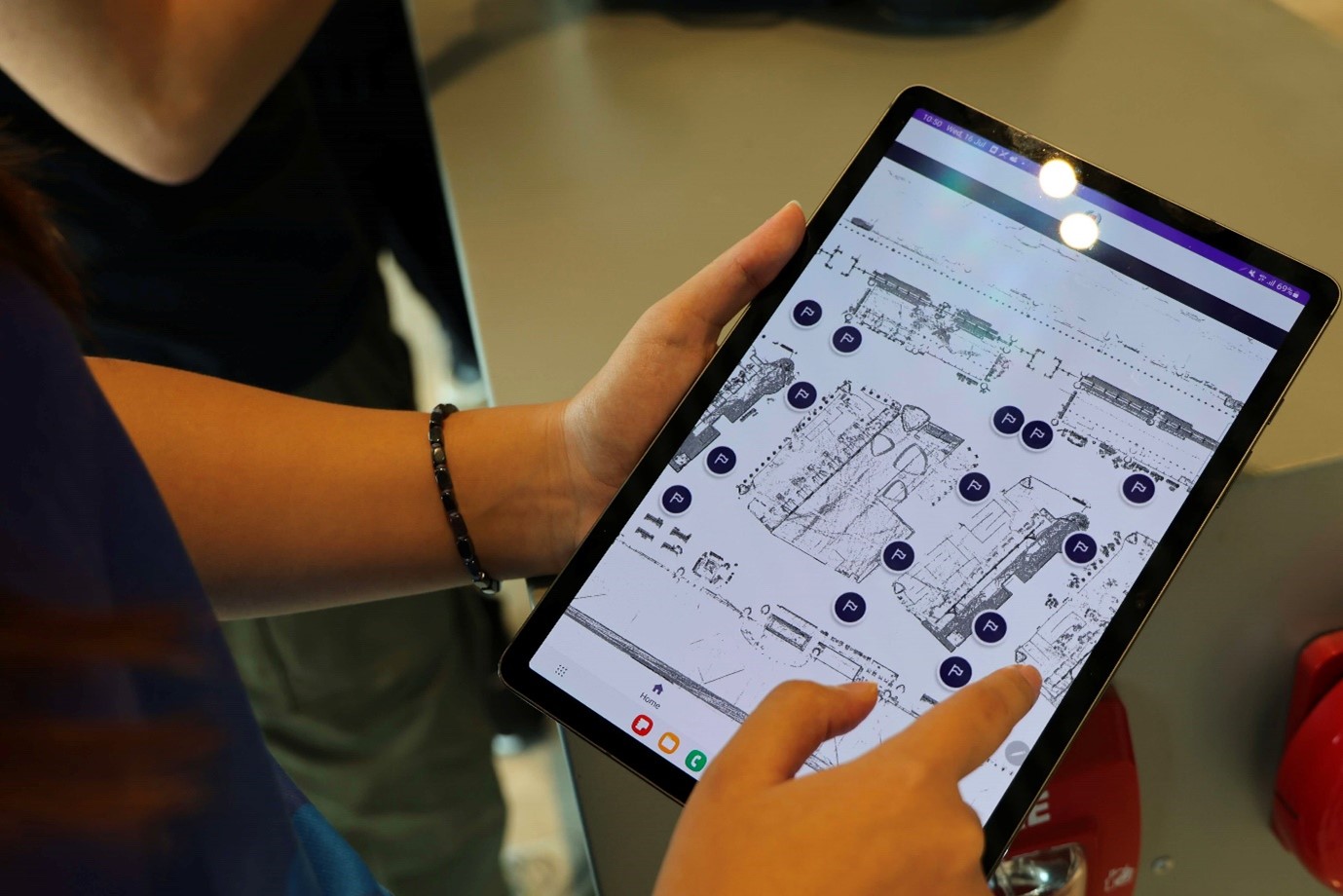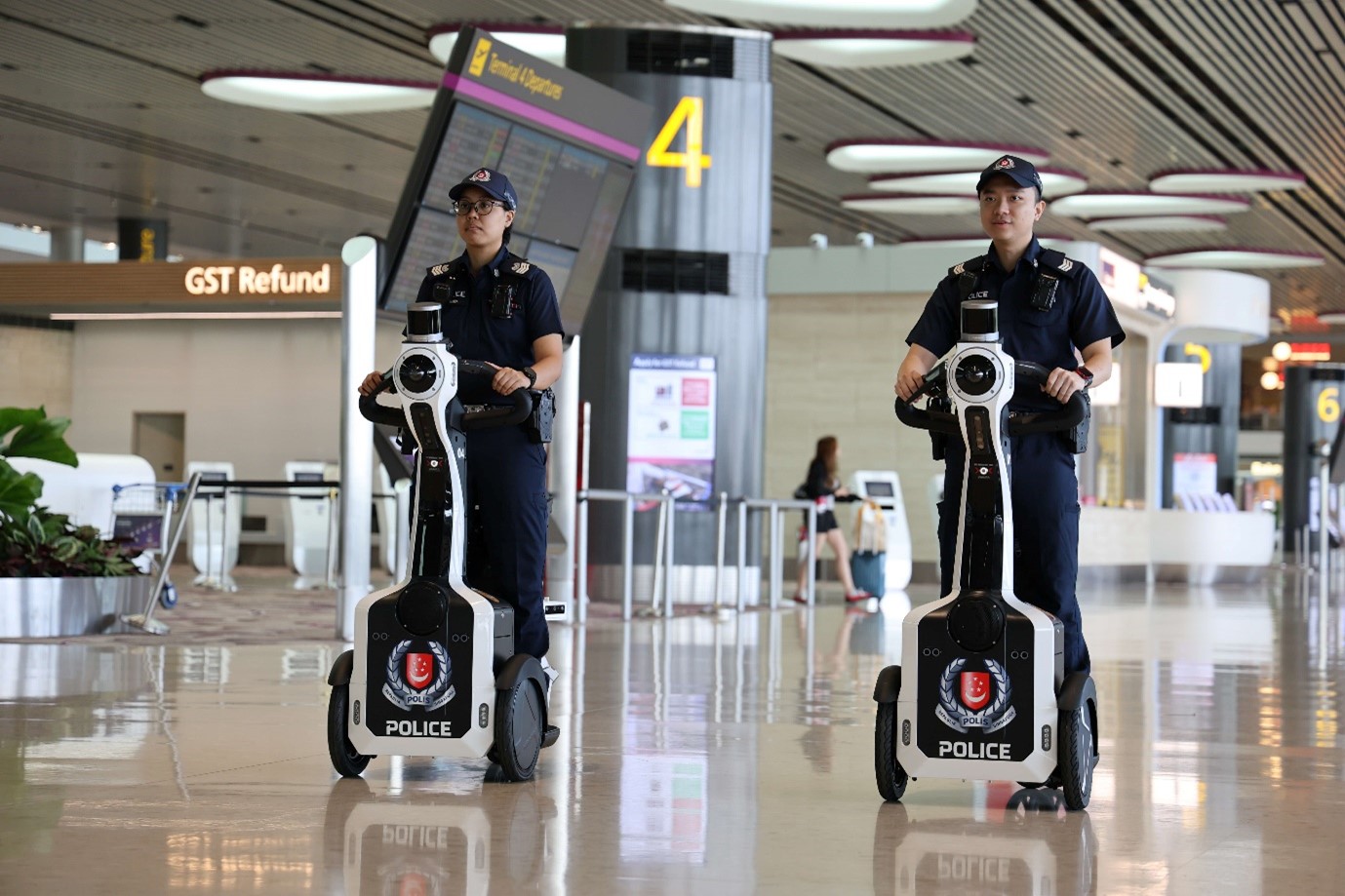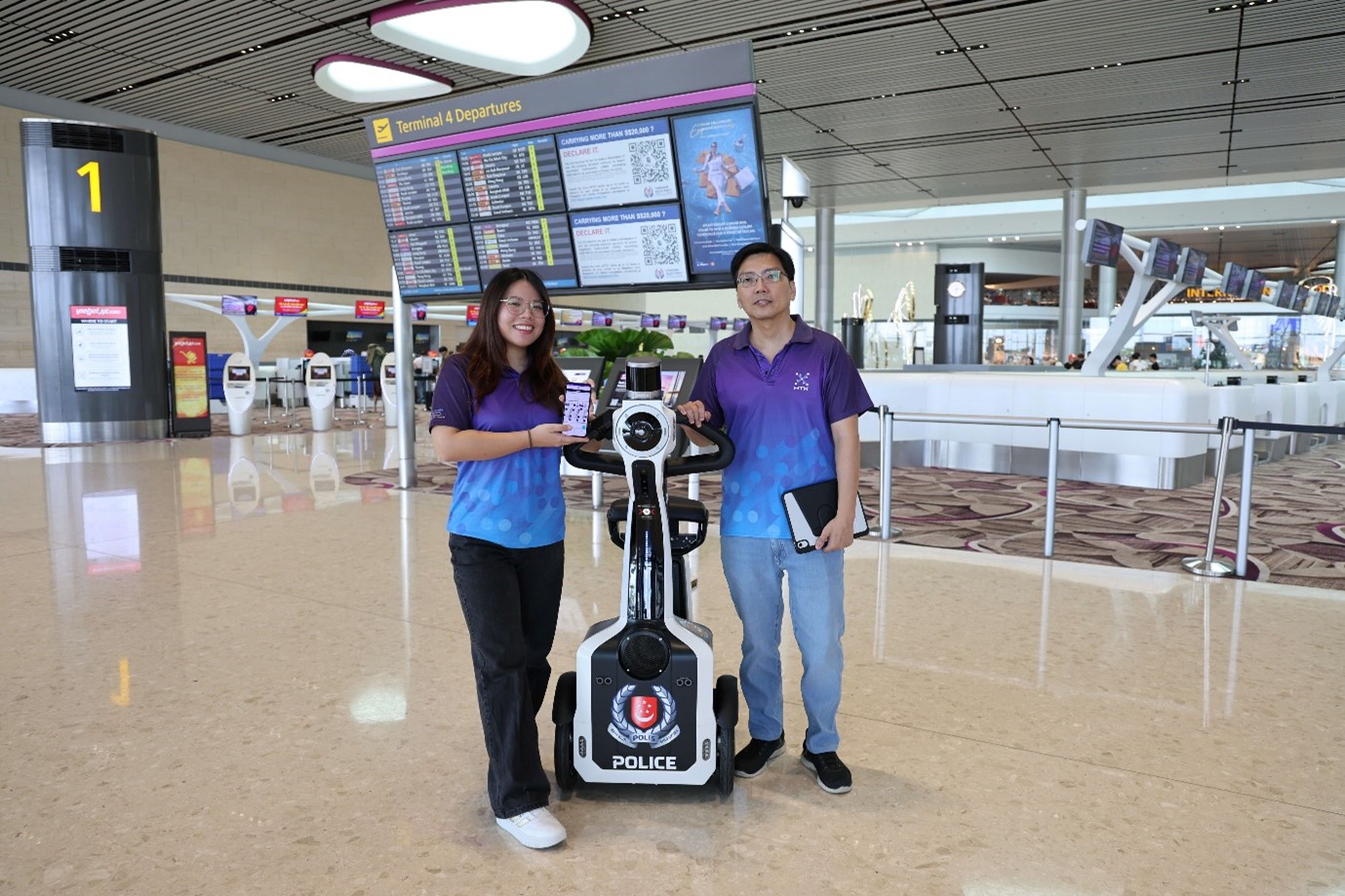 The GIBSON can be used as both an autonomous patrol bot and a PMD for officers. (Photo: HTX/Law Yong Wei)
The GIBSON can be used as both an autonomous patrol bot and a PMD for officers. (Photo: HTX/Law Yong Wei)
Anyone who has been to Changi Airport would know how sprawling this world-renowned aviation hub is. For officers from the Airport Police Division (APD), this means having to cover much ground on foot during patrols or when responding to incidents.
Now, a new robotic platform called GIBSON has the potential to expand patrol coverage and give a little reprieve to officers.
Developed by the Ground Systems team under HTX’s Robotics, Automation and Unmanned Systems (RAUS) Centre of Expertise (CoE) and researchers from the A*STAR Institute for Infocomm Research (A*STAR I²R), GIBSON is the result of upgrading the APD’s well-used Electric Stand-Up Vehicle into a personal mobility device (PMD) capable of traversing large indoor spaces and conducting autonomous patrols.
GIBSON recently started trials at Changi Airport’s Terminal 4.
But turning this vision into reality required more than just technical upgrades. In the popular imagination, autonomous robots glide effortlessly through different environments, guided by a constellation of algorithms programmed to chart their every move. While that may be partly accurate, engineer Seah Qi Yan from the RAUS Ground Systems team has come to discover that solely relying on step-by-step instructions that enable a robot to accomplish tasks has its limitations.
In fact, designing robots is as much about understanding people as it is about coding algorithms.
 Police officers at Changi Airport can summon GIBSON through an app developed by HTX. (Photo: HTX/Law Yong Wei)
Police officers at Changi Airport can summon GIBSON through an app developed by HTX. (Photo: HTX/Law Yong Wei)
The human factor
Given the multiple stakeholders involved – from the APD to A*STAR collaborators as well as Changi Airport Group and the public – conceptualising GIBSON required Qi Yan and her team to seek out varying perspectives and not simply be focused on the engineering aspect of things.
Working in lockstep with the A*STAR team, which re-engineered the PMD platform into a robot, RAUS developed a mobile application in-house that allows police officers to track the robots’ live location and summon a ride from the nearest GIBSON robot.
From the outset, the team consulted police officers to understand their needs while also paying close attention to aspects such as the application’s user interface.
“We tried to take a ground-up rather than top-down approach, as this is a new system and it is important that officers can see themselves actually using it,” she adds.
 Officers from the APD were involved in a trial of GIBSON at Changi Airport. (Photo: HTX/Law Yong Wei)
Officers from the APD were involved in a trial of GIBSON at Changi Airport. (Photo: HTX/Law Yong Wei)
This collaborative approach proved pivotal when the team ran into their first stumbling block: striking a fine balance between safety and manoeuvrability. Due to the need to adhere to the airport’s stringent safety regulations, they had to design a system that was both responsive and safe.
“Officers wanted the vehicle to zoom through areas and navigate tight spaces while manually operating the PMD, but we also had to ensure it wouldn’t accidentally hit passengers or obstacles,” shares Qi Yan.
“Even in PMD mode, we included safety features such as requiring officers to arm and activate the handlebar when they first take over manual control, to prevent accidents from occurring.”
Close communication with users and repeated trials helped them identify their sweet spot, Qi Yan added.
“We had to also consider human nature,” said Qi Yan, who shared that the team was rather surprised when they found the public to be largely unresponsive to the recorded message of “Excuse me,” that GIBSON played whenever it encountered someone in the way.
“I’m not sure if the volume was too low or people were zoning out, but they didn’t seem to notice it. As such, we changed it to a beep, and it worked!” she quipped.
And then there was playful nature of humans to take into consideration. Qi Yan shared that there were instances of people attempting to mount the PMD and hitch a ride while it was moving in autonomous mode. In response, the team installed additional sensors that would trigger a stop whenever such “hijackers” tried to pull a move. The team also placed a cordon on the robot to deter misuse.
“These experiences are valuable to me as a junior engineer because we typically work on projects in a nice, contained environment. There are many learning opportunities when you move from simulation to reality,” she said.
“Unforeseen variables such as people attempting to mount the PMD – that was something no one would have thought of in a simulated environment.”
Reshaping security
 From left: Seah Qi Yan with Ong Ka Hing, the deputy director of RAUS’ Ground Systems team. (Photo: HTX/Law Yong Wei)
From left: Seah Qi Yan with Ong Ka Hing, the deputy director of RAUS’ Ground Systems team. (Photo: HTX/Law Yong Wei)
While neither autonomous mobility devices nor patrol robots are new concepts, Qi Yan shared that combining their functions into a versatile “buddy” tailored for airport policing surfaces exciting possibilities for human-robot collaboration in public safety.
Beyond enhanced convenience, GIBSON could also transform policing operations through a tag-team approach, she noted.
“In locating a missing person, GIBSON could split the search area with the officers, as well as facilitate information sharing through the application,” she said. “This would make the search more efficient and effective.”
And how would she describe GIBSON’s personality, if it was sentient?
“It would be diligent and reliable – the perfect police sidekick!”

![[FEATURED NEWS] MiniX: Mini but mighty](/Cwp/assets/htx/images/listing-card-placeholder.png)